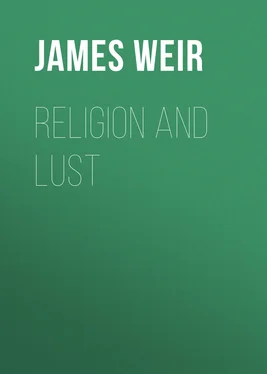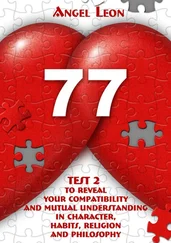James Weir - Religion and Lust
Здесь есть возможность читать онлайн «James Weir - Religion and Lust» — ознакомительный отрывок электронной книги совершенно бесплатно, а после прочтения отрывка купить полную версию. В некоторых случаях можно слушать аудио, скачать через торрент в формате fb2 и присутствует краткое содержание. Жанр: psy_sex_and_family, psy_sex_and_family, Эротика, Секс, Детская образовательная литература, Детская образовательная литература, на английском языке. Описание произведения, (предисловие) а так же отзывы посетителей доступны на портале библиотеки ЛибКат.
- Название:Religion and Lust
- Автор:
- Жанр:
- Год:неизвестен
- ISBN:нет данных
- Рейтинг книги:4 / 5. Голосов: 1
-
Избранное:Добавить в избранное
- Отзывы:
-
Ваша оценка:
- 80
- 1
- 2
- 3
- 4
- 5
Religion and Lust: краткое содержание, описание и аннотация
Предлагаем к чтению аннотацию, описание, краткое содержание или предисловие (зависит от того, что написал сам автор книги «Religion and Lust»). Если вы не нашли необходимую информацию о книге — напишите в комментариях, мы постараемся отыскать её.
Religion and Lust — читать онлайн ознакомительный отрывок
Ниже представлен текст книги, разбитый по страницам. Система сохранения места последней прочитанной страницы, позволяет с удобством читать онлайн бесплатно книгу «Religion and Lust», без необходимости каждый раз заново искать на чём Вы остановились. Поставьте закладку, и сможете в любой момент перейти на страницу, на которой закончили чтение.
Интервал:
Закладка:
According to Ross, a Konyaga woman, when she has a good-looking boy, dresses him in girl’s clothes and brings him up as a female. When he arrives at a suitable age he is sent to wait on the priests of the tribe and is introduced by them into the sacred mysteries of their cult; in fact, he becomes a masculine hetara.
When we read of such things we feel pretty much as Herodotus felt when he saw the naked women of Mendes submitting themselves openly ες επιδειξιν ανθρωπων to the embraces of the sacred goat. 48 48 Herodotus: Euterpe , 46.
To the Greek historian this act was simply horrible (τερας); and yet these Egyptians experienced no repugnance whatever. To them it represented the incarnation of the deity, and was, therefore, a sacred and holy action, just as masculine hetarism is regarded as a holy profession among the Konyagas. Phallic hetarism is one of the sacraments of the Konyaga church, and, as such, it is held in all that reverence and awe with which the savage devotee endows the mysteries of his faith. 49 49 Masculine hetarism is still in vogue among many primitive peoples, and is distinctly a religious rite. “The Kanats of New Caledonia frequently assemble at night in a cabin to give themselves up to this kind of debauchery… In the whole of America, from north to south, similar customs have existed or still exist.” Letourneau: The Evolution of Marriage , p. 62. The same author says: “It was also a widely spread custom throughout Polynesia, and even a special deity presided over it. The Southern Californians did the same, and the Spanish missionaries, on their arrival in the country, found men dressed as women and assuming their part. They were trained to this from youth, and often publicly married to the chiefs. Nero was evidently a mere plagiarist. The existence of analogous customs has been proved against the Guyacurus of La Plata, the natives of the Isthmus of Darien, the tribes of Louisiana, and the ancient Illinois.”
The ancient Hebrews, ancestors of one of the most ancient of the civilized races of the earth, held it in high honor. Even wise King Solomon, in the days of his old age, turned from the abstractedly pure religion of his father “to Astoreth, the goddess of the Zidonians, and to Milcom, the abomination of the Ammonites.” 50 50 I Kings : chap xi, verse 5.
He was guilty of constructing a “high place” for Chemosh, “the abomination of Moab.” 51 51 Ibid. , verse 7.
Any good modern biblical encyclopedia will tell the reader about Astoreth and her worship, and what the “high places” and the “groves” were.
Even the “good kings,” such as Asa, Amaziah, et al. , did not remove the high places and the groves, for we read that, notwithstanding the fact that these kings did that which was right in the sight of the Lord, they did not remove the high places. In the case of Amaziah, it is written:
“And he did that which was right in the sight of the Lord, yet not like David, his father; he did according to all things as Joash, his father, did.
“Howbeit, the high places were not taken away: as yet the people did sacrifice and burnt incense on the high places.” 52 52 II Kings : chap. xiv, verses 3, 4.
All of the so-called “wicked kings” were phallic worshipers, and both male and female hetarism flourished during their reigns. We read of Josiah, a “good king,” “And he broke down the houses of the sodomites ( kedescheim ) that were by the house of the Lord.” 53 53 Ibid. , chap. xxiii, verse 7.
Here, in unmistakable terms ( kedescheim ), the phallic act of the hetara is specified.
Herodotus wrote: “Almost all mankind consort with women in their sacred temples, except in Greece and Egypt.” 54 54 Herodotus: Euterpe , 64.
This is a queer mistake for a Greek to make, yet this historian is noted for his unreliability, and we should not feel surprised at this gross error. Concerning the Aphrodite of Abydos, what she was and what took place in her temples, is a matter of history. Indeed, this goddess was surnamed Porne ! In Corinth, delubral hetarism was openly practiced; also at Bubastis and Naucratis in Egypt. Royal princesses were pallacides in the temple of Ammon; in fact, they took pride in the title of pallakis ! 55 55 Strabo, when writing of the Armenians, who were phallic worshipers, says: “It is the custom of the most illustrious personages to consecrate their virgin daughters to this goddess (Anaïtis). This in no way prevents them from finding husbands, even after they have prostituted themselves for a long time in the temples of Anaïtis. No man feels on this account any repugnance to take them as wives.” Strabo: vol. xi., 14; quoted also by Letourneau: The Evolution of Marriage , p. 46.
“It is known what excessive debauchery took place in the ‘groves’ and ‘high places’ of the ‘Great Goddess.’ The custom was so deeply rooted that in the grotto of Bethlehem what was done formerly in the name of Adonis is to-day in the name of the Virgin Mary by Christian pilgrims; and the Mussulman hadjis do likewise in the sanctuaries of Mecca!” 56 56 Reclus: Primitive Folk , p. 69; Sepp: Heidenthum u. Christenthum .
57 57 Brugsch Bey is of this same opinion.
But let us return to primitive peoples, from whose customs and beliefs we can learn what our own ancestors must have believed before the besom of civilization swept aside the crudities of savagery.
The Khonds of India are phallic worshipers, and, in the practice of their religion, Priapus saves many a girl who would be, otherwise, offered up on the bloody altars of their divinities. The pregnant woman is sacred, hence, religious prostitution is exceedingly prevalent. But it frequently happens that some unfortunate creature, who is not pleasing to the shamans, is seized, tied to the stake and butchered. 58 58 Sherwill: The Rajmahal Hills .
As the blood flows down and deluges the ground, “the divine spirit enters into the priest and inspires him.” 59 59 Reclus: Primitive Folk , p. 317.
This sacrifice is of itself a phallic rite; the blood-offering is supposed to be exceedingly acceptable to Earth, the mother of all things. Blood is the essence of the life-giving principle; hence, the essence is returned to the great Giver, as a propitiatory offering. 60 60 Among certain peoples the blood and the semen bore a close relationship; by certain races they were considered analogous. The Old Testament, the Vedas, the Sagas, and many references of Greek, Latin, Egyptian, Hindu, and Persian mythology point to this as being conclusive.
In point of fact, the worship of the generative principle is everywhere prevalent in India. 61 61 Speaking of the ceremony of priestly prelibation as it was practiced in the Kingdom of Malabar, Forbes writes as follows: “The ecclesiastic power took precedence of the civil on this particular point, and the sovereign himself passed under the yoke. Like the other women, the queen had to submit to the right of prelibation exercised by the high priest, who had a right to the first three nights, and who was paid fifty pieces of gold besides for his trouble.” Forbes: Oriental Memoirs , vol. i, p. 446; quoted also by Letourneau: The Evolution of Marriage , p. 48. De Rémusat says that, in Cambodia, the daughters of poor parents retain their virginity longer than their richer sisters simply because they have not the money with which to pay the priest for defloration!
In the Lingam, or holy altar of the Brahmins, we see a conjunction of the male and female sexual organs, while religious prostitution, in the shape of hetarism, crowds the inner courts and corridors of almost every temple in the land with hierodules and bayaderes. The Vedas abound in references, either direct or indirect, to phallic worship. Indeed, according to some authorities, the Hindu Brahma is the same as the Greek Pan, 62 62 “The people have put the idol named Coppal in a neighboring house; there she is served by priests and Devadichi , or slaves of the gods. These are prostitute girls, whose employment is to dance and to ring little bells in cadence while singing infamous songs, either in the pagoda or in the streets when the idol is carried out in state,” writes Letourneau in The Evolution of Marriage , quoting from Letters édifiantes . Coppal was and is a Brahminical Venus, and her worship is wholly phallic in character. The ancient Indo-Iranians worshiped a similar deity. The worship of Coppal, both in ritual and in significance, is identical with that of the Greek Aphrodite.
“who is the creative spirit of the deity transfused through matter.” 63 63 Brugsch, Knight, Müller, et al.
Интервал:
Закладка:
Похожие книги на «Religion and Lust»
Представляем Вашему вниманию похожие книги на «Religion and Lust» списком для выбора. Мы отобрали схожую по названию и смыслу литературу в надежде предоставить читателям больше вариантов отыскать новые, интересные, ещё непрочитанные произведения.
Обсуждение, отзывы о книге «Religion and Lust» и просто собственные мнения читателей. Оставьте ваши комментарии, напишите, что Вы думаете о произведении, его смысле или главных героях. Укажите что конкретно понравилось, а что нет, и почему Вы так считаете.












